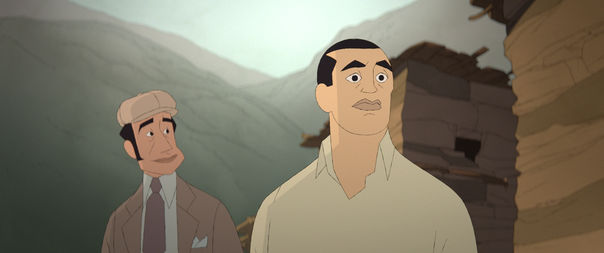Buñuel Making a Documentary?
By Denise Roldán

The art of cinema, emulating reality, allows questions with no answers to be asked and answered. With Buñuel En El Laberinto De Las Tortugas (Buñuel in the Labyrinth of the Turtles), his first feature-length animated film, Salvador Simó, asks himself how the young filmmaker from Aragón, after making the documentary Las Hurdes: Tierra Sin Pan (Land without Bread), transformed himself into Luis Buñuel.
Buñuel went through a creative crisis following the uproar caused by L’age D’or (The Golden Age). Only his sculptor friend Ramón Acín believed in him, promising to produce his first documentary film. Luck was on their side. Acín won a lottery and they undertook to explore the labyrinth of Las Hurdes, a poverty-stricken region near Madrid. Simó’s animated film follows the artist on his journey, focusing on this introspective stage in Buñuel’s career, as he asked himself what kind of filmmaker he wanted to be and what was motivating him to continue along the path of cinema.
The film is based on a graphic novel by illustrator Fermín Solís, but it makes its own way, in terms both of design and storyline. The latter gives priority to the inner conflicts associated with the making of the documentary, quite apart from its repercussions on the outer world. The animation of Las Hurdes provides a space and time for two stories: Buñuel’s transition from a purely visual to a socially-committed surrealism, and his friendship with Ramón Acín, as it developed through the vicissitudes of shooting the documentary. The former storyline explores the surrealist’s own dreams, showing how his dilemmas of the past affected his actions in the present. Little Luis astonishes others with his manipulations of insects; young Buñuel moves the elements he controls to create sequences that strike the viewer. The thirty-two-year-old filmmaker is not an observant documentary-maker: on the contrary, he configures his scenes as he wishes them to be. In the second storyline, anecdotes about the filming map out a path of circumstances that lend themselves to comedy, but Simó moves from laughter to seriousness and back again, portraying the chiaroscuro of life itself by using the colors of his art design and the black-and-white of the original production.
The inner conflict moves toward a satisfying visual dénouement. Buñuel en el laberinto de las tortugas follows a natural path, very different from what one might expect from a film about the celebrated surrealist, because it explores Buñuel through his own creations. The rather stiff animation and the simple drawing of the characters and backgrounds are not drawbacks: the discourse is configured by means of gestures and moments of little movement. The dramatic progression is propelled by Buñuel’s confrontation with reality, rather than with how the filmmaker actually behaved in certain situations.
Simó has used the techniques of animation skillfully to recreate a world that no longer exists, that perhaps never existed. Beyond illuminating that reality, his film, with its dramatic portrayal of Buñuel, brings a complex figure back to life as an artist and a person: a man who emerged from the labyrinth with a style of his own, destined to take a place in the history of cinema.
Translation: Gregory Dechant

